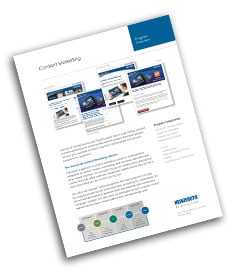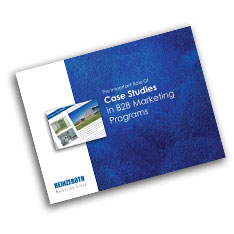
While inbound marketing (content marketing) is becoming an ongoing initiative for many companies, its adoption in industrial OEM markets is growing at a somewhat slower, yet steady rate. Do inbound marketing methods apply to industrial OEM and component businesses that target engineers and other technical professionals? Even if those businesses sell to only a small number of companies? We would say Yes! Here’s why.
First, to define inbound marketing as we are considering it here, we are speaking of all-in-one customer engagement methodologies utilizing a platform such as HubSpot, a tool that we use to create, automate, optimize and measure all of a company’s online marketing. Other leading platforms include Sharpspring, Net-Results, MindFire plus the CRM functions of Salesforce, SAP, Oracle and other enterprise solutions.
Among the first steps in implementing inbound marketing is to strengthen your website with Calls To Action (CTAs) along with landing pages and forms, a selection of ebooks, whitepapers, case studies, videos and other assets that can be viewed and downloaded. Adding a blog is also proven to enhance a website’s search ranking and ultimately the ability to attract traffic, capture and convert leads.
Rather than depending only on advertising, cold calling and other “push” tactics to build contacts, inbound marketing helps you organize and customize information that is of interest to prospects at each stage of the buying process. It further involves programming of automated emails and other followup communications tailored to those individual prospects’ interests and buying stage. And it provides real-time tracking and reporting of all activity by each contact.
It’s clear that many industrial marketers recognize the need for such engagement strategies. In the following table from an Engineering 360 survey, the top two challenges noted by industrial marketing professionals is “Generating Leads for Sales” and “Measuring the ROI of My Efforts.” Both of those challenges are addressed by and are actually key advantages of the inbound marketing process.
Biggest Challenges - Industrial Marketers
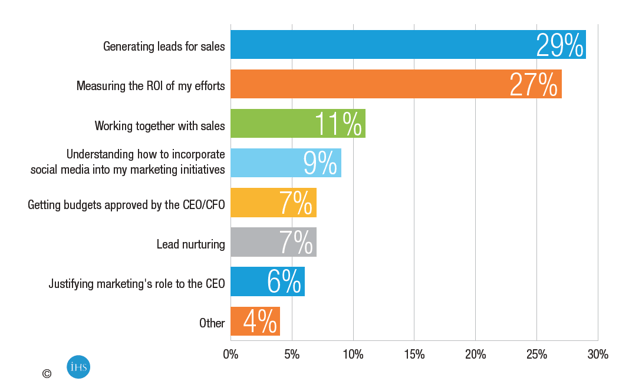
Source: IHS Engineering 360, 2015 Industrial Marketing Trends.
In a 2017 followup survey, also by Engineering 360, the use of content marketing by all types of manufacturing marketers is now up to 85%. And of the 15% of nonusers, more than half say they plan to launch a content marketing effort within 12 months.
For industrial OEM marketers, some reasons to explore inbound marketing include:
1. There are more potential contacts than you may think
Even if your company serves a relatively small number of industrial customers, there are many players in the channel that your direct sales force can’t possibly know or contact often. That’s where content marketing shines, working in the background to maintain and nurture interest, and also to reinforce your position across functional areas of current customers.
As shown in this table, there are multiple layers of stake holders that can have a voice in specification and procurement decisions. Have you considered them all? Note too that only some of them are making decisions based primarily on technical specifications. And regardless of job function, they are all seeking content that articulates benefits and demonstrates value.
These individuals are also changing jobs and companies frequently. This reality applies equally to process equipment and supplies that are used in manufacturing processes as well as to OEM components that become part of your customers’ end products.
Job Functions That Can Have A Voice In Specifying Your Products
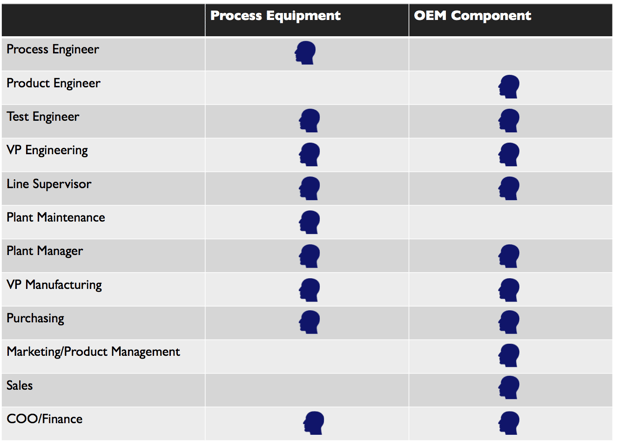
Add to that number the emerging companies in your industry or in other segments that are not yet on your radar but may one day be of interest to you, plus the stocking and servicing distributors as well as branch personnel that currently provide essential support for your brand. Taken together, these can represent a vast number of potential contacts.
Inbound marketing can work magic by staying in touch at all of those levels and by unearthing new opportunities, profiling interests and growing relationships before you or your sales team places any new prospect in the crosshairs.
2. The more expensive or complex an OEM purchase is, the longer the buyers’ journey will take
In some industries, the buying cycle is getting shorter. That isn’t necessarily true of technical products, especially more costly and complex products for which the risk associated with making an incorrect decision increases. Purchases greater than $10,000 may take 9 months or more. With a content marketing strategy, you can stay engaged with prospects throughout the process:
Research and needs analysis
initiatives (examples):
Search engine advertising linked to landing pages offering a whitepaper, blog articles with ebooks, online catalogs, automated followup emails referencing case studies
Comparison and evaluation
initiatives (examples):
Lead nurture emails linked to landing pages offering case studies, social posts of those case studies, product comparison summaries, lead nurture emails, product demonstration videos, sales team notifications
Purchase
Initiatives (examples):
Thank you emails, maintenance tips bulletins, additional case studies to affirm product reliabiilty, eNewsletters, articles
3. Many OEM buyers review multiple pieces of content, especially if the purchase is technical or complex
At this point you might ask: Why place a lot of emphasis on new marketing tactics if I already know the key industry players personally?
Beyond the fact that you probably don’t know them all is the reality that many buyers prefer to do their own research. Inbound marketing allows you to create and share information that is relevant to specific interests of different buyers as they do their research. It is also common practice for industrial buyers to send out RFQs to at least three suppliers. That "rule of 3" is true across most companies and industries. Never assume that your products are a shoe-in.
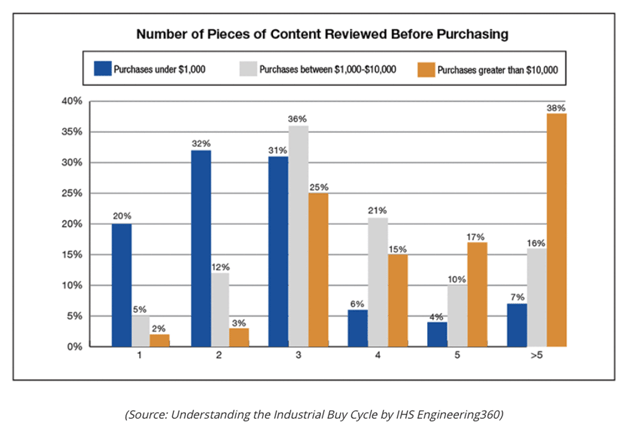
4. Online content is a first resource for technical professionals
Though engineers and technical professionals can have very specific criteria for evaluating products, they are “humans” first, following the general trend toward use of more online sources for information relating to B2B purchases. This underscores the need to do everything possible to ensure that your online content is accessible and the more valuable content is “gated” with landing pages designed to gather leads for your followup activities.
Top Sources Of Information Used By Industrial Buyers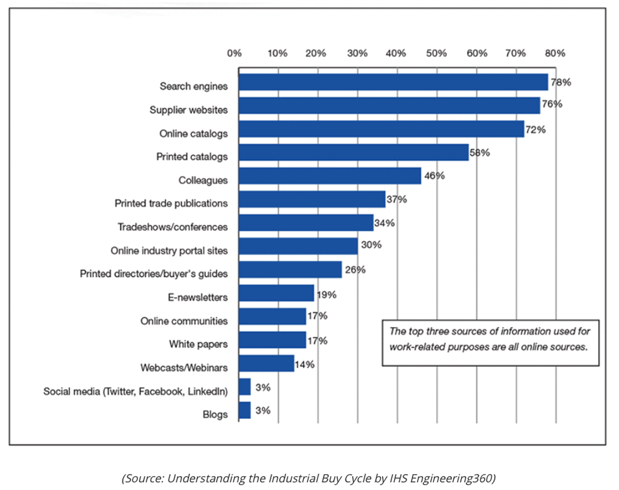
5. Technical professionals are also using social media for work-related research
Not to be forgotten in any inbound marketing program, social media is also becoming a more widely used resource for information about industrial products. For more on this, check our related blog article.
A robust platform such as HubSpot enables us to publish and monitor your business-related social media activity all in one place. We can easily link your posts as well as digital advertising to landing pages on your website.
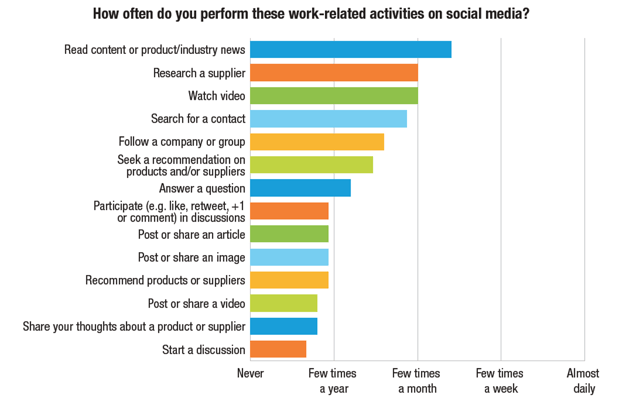
(Source: Social Media Use of Technical Professionals, IHS Engineering 360 2016.)
6. Case studies are key to positioning your company as a technology leader
In our work for industrial companies, the use of case studies has become a key central focus of content strategy. Case studies, or “application profiles,” serve as proof of how your technology is being applied across key markets. A good case study library can be segmented by market and says much about your company’s engineering leadership and bandwidth.
Some of the ways we utilize case studies include:
- Subjects of emails sent to key prospects
- Lead nurture emails sent in followup to inquiries
- Resources for the sales team to use in personal calls as well as in their emails
- Articles for engineering/technical publications
- Round-up newsletters sent periodically to prospects as well as current customers
- Posting on social media such as LinkedIn
- Using them as central topics in digital as well as print advertising
- Referencing the application stories in technical papers
- Reinforcing key points of a presentation at industry and professional association events
There are many approaches to developing an ongoing case study program. It does take commitment, just as it does to making the plunge into content marketing. Our communications professionals can take some of the weight off your shoulders. We work closely with clients’ product management, engineering and sales teams to identify interesting applications, arrange for photos and videos of the installations, interview customers and then prepare either short summaries (profiles) or more expanded stories (articles) that are also pitched to key trade journal publishers.
Inbound marketing is earning a key role in the marketing of technical products to OEM customers. It can serve as a truly integrated platform for marketing in an environment where purchasing decisions involve a collaboration of multiple players, If you’d like to explore how to get started, its budget implications and related matters, please contact us.
Learn more about how to implement a successful, ongoing Content Marketing Program.
Download this free guide to developing a library of case studies that will add new energy to your industrial marketing program.

